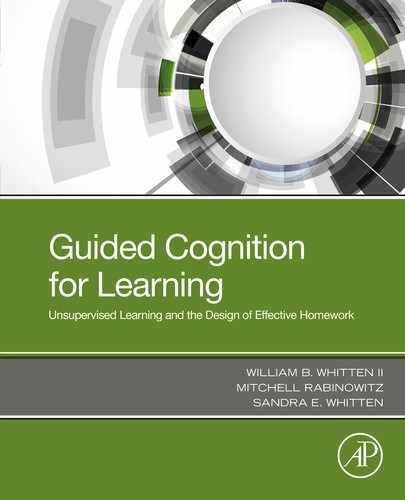Index
‘Note: Page numbers followed by “f” indicate figures, “t” indicate tables.’
Advanced-ability students
Act III and Act IV homework questions, 18–19
Act III of Macbeth
checkmarks, 44–45
cognitive event (GC) homework questions, 43
design and procedure, 43–44
Guided Cognition experience, 50–51
mean course grades, 44–45
overall Guided Cognition effect, 45
participants, 43
proactive effects, Guided Cognition experience, 42
process-focused cognitive events, 42
Becket
content retention, 32–33
design and procedure, 31–32
homework sheet, 31
participants, 30
review activity (quiz), 31
self-recorded clock start and stop times, 33
time spent on homework, 34f
experiment timeline, 19
Guided Cognition homework questions, 18
participants, 17
perceptions and preferences survey, 18
Shakespeare’s Macbeth
content-focused cognitive events, 35
design and procedure, 35–36
participants, 35
Traditional homework questions, 17–18
Anti-homework sentiments, 2
Average-ability students
Act III and Act IV homework questions, 18–19
Act III of Macbeth
checkmarks, 44–45
cognitive event (GC) homework questions, 43
design and procedure, 43–44
Guided Cognition experience, 50–51
mean course grades, 44–45
overall Guided Cognition effect, 45
participants, 43
proactive effects, Guided Cognition experience, 42
process-focused cognitive events, 42
experiment timeline, 19
Guided Cognition homework questions, 18
metacognitive/planning/evaluative process-focused cognitive events
The Outsiders
4-day delayed quiz, 40
design and procedure, 39
participants, 38
quiz performance, 38–40
participants, 17
perceptions and preferences survey, 18
Shakespeare’s Macbeth
content-focused cognitive events, 35
design and procedure, 35–36
participants, 35
Traditional homework questions, 17–18
Chicago Tribune survey, 5
Cognitive events, 140t
authentic learning environments, 14–15
content-focused cognitive events, 12–14
learning behaviors, 11–12
in mathematics experiment, 133
process-focused cognitive events, 14
relate to prior experience
cognitive processes, 136
execution, 136
frame of, 135
interpretation, 135
research strategy, 15
role play
cognitive processes, 135
execution, 135
frame of, 134
interpretation, 134
in literature homework, 143
in mathematics homework, 143–144
steps for authoring, 133–134
to-be-learned content, 14–15
visualizing and illustrating
cognitive processes, 138
execution, 138
frame of, 137
interpretation, 137–138
Content-focused cognitive events, 12–14
Guided Cognition homework
advance organizer/consolidator
average problem-solving performance, 105–106
6-day delayed review activity, 106
design and procedure, 103–105
in-class homework materials, 102–103
mathematics instructional materials, 102
mean pre-experiment grade, 105
participants, 102
problem-solving practice, 101–102
standard teaching strategies, 106
advantage, 66
authoring guidelines
brainstorm and evaluate, 175
mathematics research, 177
role play, 185–186
visualizing and illustrating, 180–181
Condition GC problem, 63
Condition T problem, 62
design and procedure, 63–64
effectiveness
Condition GC students, 76
Condition T homework, 76
in-class homework materials, 72–73
multiplication homework performance, 76
participants, 72
problem-solving ability, 75
generality of, 155
Guided Cognition effect, 65
instructional design, 155–156
numerical-only problem, 63
participants, 62
reading completed examples
design and procedure, 88–89
long-term benefits, 92
materials, 88
participants, 88
pre-experiment grade averages, 89
spacing-of-tests effect, 91–92
review activity
advantage, 71
in-class homework condition, 69–70
materials, 67
mean pre-experiment grade, 68
unequally weighted analysis, 68–69
design and procedure, 94–95
in-class homework materials, 93
participants, 93
pre-experiment grade averages, 95
review activity (quiz) performance, 95
students’ perceptions and preferences
Acts III and IV, 125
cognitive event, visualizing and illustrating, 126
hypotheses, 112
Macbeth Act V, 124
self-authored questions, 123–124
student-authored homework question, 126
usefulness ratings of students, 115
and Traditional homework, 161–162
Holmdel High School, 159
Homework
in American education
age groups, 5
anti-homework sentiments, 2
arithmetic homework, 2
Chicago Tribune survey, 5
cognitive events, 6
criticisms, 3
in elementary school, 4
high school students, 3
history, 2
homework reform movement, 3
individualize assignments, 3
junior high students, 3
learning benefits, 6
Met Life Survey, 5
National Assessment of Educational Progress (NAEP), 4–5
Progressive Education Association, 3
psychological research, 6
in college, 1–2
functions, 1
learning time, 1–2
materials for condition GC, 166–167
materials for condition GC + M, 168–170
materials for condition T, 163
materials for condition T + M, 164–166
new-style Guided Cognition (GC) homework, 14–15
reverse engineering, 11
Traditional (T) homework tasks and questions, 14–15
Literature, See
Advanced-ability students
, Average-ability students
Mathematics experiments
basic geometry concepts
computation-only problems, 54
Condition GC problem, 55–57
design and procedure, 55–56
in-class homework assignment, 54
participants, 54
Traditional story problems, 54
Guided Cognition homework, See
Guided Cognition homework
positive and negative integer addition
computation-only integer problems, 60
Condition T problem, 58
design and procedure, 59–60
in-class homework assignment, 57–58
integer story problems, 58
opposite-sign addition problems, 58
participants, 58
same-sign addition problems, 58
problem-solving ability
Condition GC, 77–78
Condition T, 77–80
design and procedure, 78–79
mean pre-experiment grade, 79
multiplication homework performance, 79–80
participants, 78
reading completed examples
Condition GC, 81
Condition T, 81
design and procedure, 83–84
in-class homework materials, 82–83
learning advantage, 86
mean pre-experiment grade, 84–85
participants, 82
Met Life Survey, 5
National Assessment of Educational Progress (NAEP), 4–5
Port Chester Middle School, 159–160
Process-focused cognitive events, 14
Progressive Education Association, 3
Students’ perceptions and preferences
advanced-ability students
Acts III and IV students, 129
baseline Acts I–II data, 127–128
Condition GC students, 127–128
average-ability students, 130
dimensions of design, 110
empty vessel, 109–110
homework, 110–111
homework-authoring experiments, 132
homework-choice experiments, 132
learning-effective cognitive processes, 111
student motivation, 111
“The Secret Sharer”, 26–28
Traditional homework, 161–162
design and procedure, 119
homework materials, 118–119
participants, 118
Unsupervised individual learning
computer-based resources, 156
Internet-based study, 156
questions and tasks
embody cognition, 151
Guided Cognition design, 149
hints and directions, 150
interleave practice/study, 149–150
retrieval practice, 150
scaffolding, 150
space practice/study, 149
student improvement, 145–147
William R. Satz Middle School, 159
..................Content has been hidden....................
You can't read the all page of ebook, please click here login for view all page.
